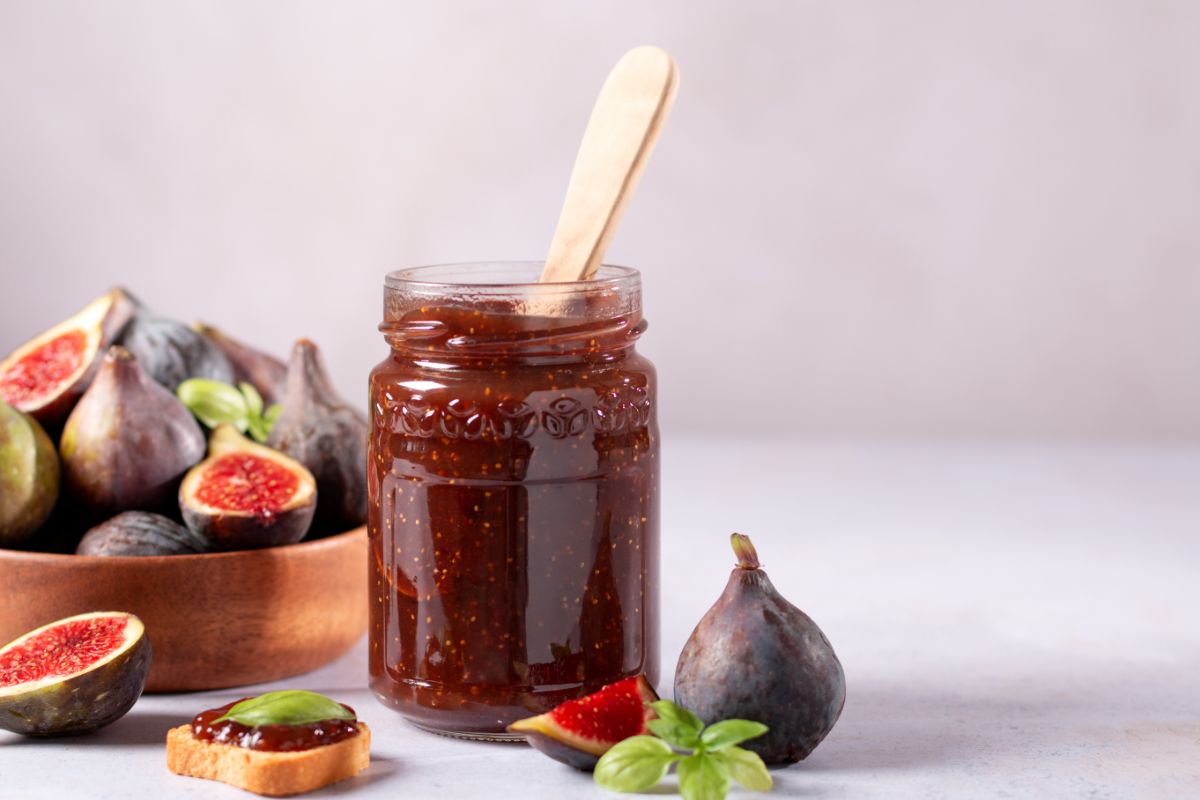Canning figs begins by removing leaves and briefly blanching the figs in hot water. Hot pack the figs in sugar syrup and place them into sterilized canning jars. Use a boiling water bath canner to process the figs for 45-65 minutes.
Should Figs Be Water Bath Canned or Pressure Canned?
As no official guidelines exist for pressure canning figs, the fruits should be water-bath canned. Figs have a borderline pH of 4.6 to 5.0, meaning they sit on the fence between acid and low-acid foods. The proper acidification of figs by adding lemon juice or citric acid is required before processing them in a water bath. This creates an acidic environment crucial in blocking the growth of botulism spores.
Print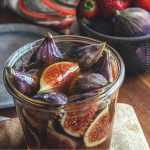
Home Canning Figs Recipe
- Total Time: 1 hour, 25 minutes
Description
This home-canning figs recipe will help you easily preserve your fig harvest to enjoy all year! While this recipe is for whole figs, you may also quarter, halve, or slice them with excellent results.
Ingredients
- 16 pounds fresh figs, washed and whole
- 2 1/4 cups sugar
- 9 cups water
- 14 tbsp bottled lemon juice
Instructions
- Prepare your canning equipment. Wash canning jars, lids, and rings in hot, soapy water and rinse well.
- Submerge the clean jars in boiling water for 10 minutes, then keep them hot until ready to use. Sanitize canning lids per your manufacturer’s instructions.
- Fill your water bath canner halfway, add a canning rack, and heat the water on a stove.
- Wash your ripe figs while scrubbing them gently under running water. Rinse and drain the water from the figs. Remove the leaves but allow the stems and skin to remain intact.
- Create light syrup by combining 9 cups of water with 2 ¼ cups of sugar in a clean saucepot and bring it to a boil over high heat while stirring to prevent scorching.
- In a large pot, bring water to a boil. Add your figs to blanch in the boiling water for 2 minutes, then drain thoroughly.
- Transfer the drained figs to the pot of boiling syrup. Let the mixture boil together for 5 minutes. Turn off the heat.
- Set out your pint jars or quart jars and add 2 tablespoons of bottled lemon juice per quart or 1 tablespoon for each pint jar.
- Ladle the figs and hot syrup into the hot jars with the lemon juice, leaving ½ inch headspace. Ensure the figs are submerged in the cooking syrup.
- Remove air bubbles using a bubble popper or wooden spatula. Adjust the headspace as required.
- Wipe the jar rims with a damp cloth. Place lids, add ring bands, and screw them on until fingertip tight.
- Load the filled jars carefully into your boiling water canner using a jar lifter. Place the canner’s lid on top and let the water resume a rolling boil over medium-high heat.
- On your timer, set a processing time of 45 minutes for half-pint or pint jars or 50 minutes for quart jars. Adjust time per elevation as necessary:
Water Bath Canning Processing Time per Altitude
- 0 – 1000ft: Pint jars 45 minutes; quart jars 50 minutes
- 1,001 – 3,000ft: Pint jars 50 minutes; quart jars 55 minutes
- 3,001 – 6,000ft: Pint jars 55 minutes; quart jars 60 minutes
- 6,001ft and up: Pint jars 60 minutes; quart jars 65 minutes
Post Processing
- Once the recommended time lapses, turn off your stove. Uncover your canner and let the jars sit in hot water for 5 minutes.
- Using canning tongs, lift the jars from the hot water. Position them on a towel-covered surface to cool undisturbed for 12-24 hours.
- After cooling properly, confirm the seals on each lid. Sealed lids curve downwards, displaying a concave shape, and have stationary lids.
- Put unsealed jars in your refrigerator and use them within a week.
- For properly sealed jars, wipe the outside of the sealed jars and lids. Remove screw bands and label with the contents and canning date.
- Store them in a cool, clean, dry place away from direct sunlight.
- Prep Time: 15 minutes
- Canning Time: 50 minutes
- Cook Time: 20 minutes
Nutrition
- Serving Size: 100g
- Calories: 74kcal
- Sugar: 16g
- Sodium: 1mg
- Fat: 0.3g
- Saturated Fat: 0.1g
- Carbohydrates: 19g
- Fiber: 2.9g
- Protein: 0.8g
- Cholesterol: 0mg
Is it Safe to Can Fig Jam?
Yes – it’s possible to can fig jam, with or without pectin, in a water bath safely. According to the National Center for Home Food Preservation, when making jam or canning figs, add lemon juice or other acidic ingredients like citric acid to ensure sufficient acidity to prevent the growth of harmful bacteria.
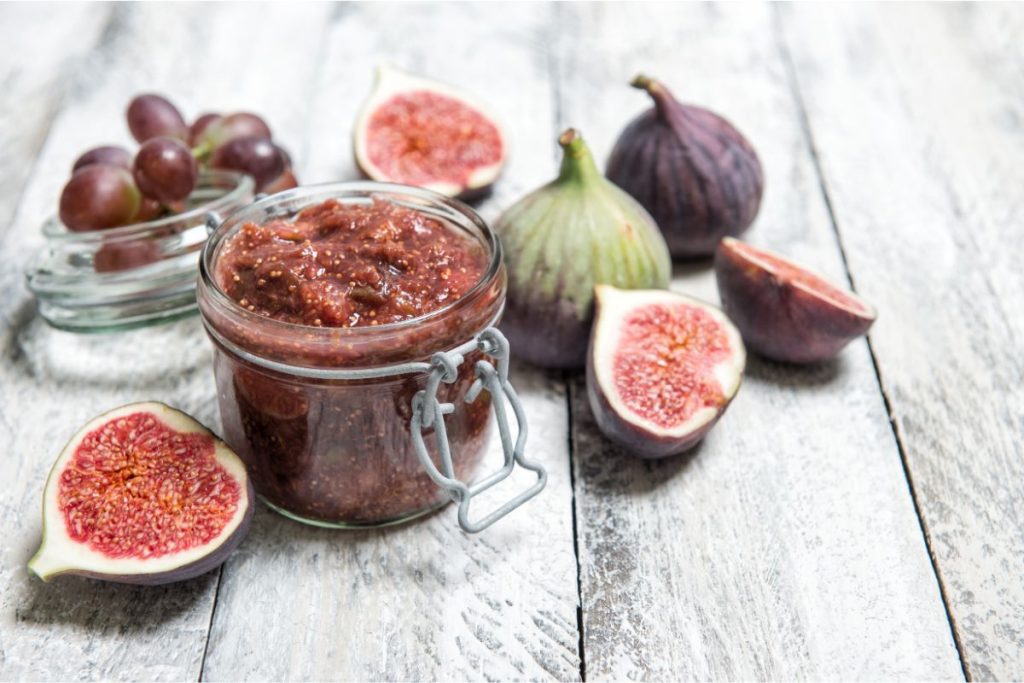
How Do You Prepare Fresh Figs for Canning?
When water bath canning whole figs, prepare them for canning by following these steps:
- Select the best-quality figs that are fresh, fully ripe, and firm and with uncracked/blemished skin. Do not use figs with soft flesh as it indicates over-maturity.
- Wash figs thoroughly under cool, plain, running tap water. Rinse them well and drain them using a colander.
- Pat the figs dry with a clean paper towel.
- Remove the leaves and the longer stems. Figs aren’t peeled when canning, and the short stems are left intact.
- Blanch the fruits in water for 2 minutes. This process prevents floating fruit when packing and preserves the color and flavor. Once blanched, place figs in canning jars and process in a water bath canner.
What Equipment is Needed for Canning Figs?
For canning figs, you’ll need the following equipment as part of your canning kit:
- Bubble popper tool
- Glass canning jars
- Jar lifter or canning tongs
- Jar rack
- Kitchen timer
- Ladle
- Large wooden spoons
- New canning lids
- Rings or metal screw bands
- Stockpots or pans
- Water bath canner
- Wide mouth canning funnel
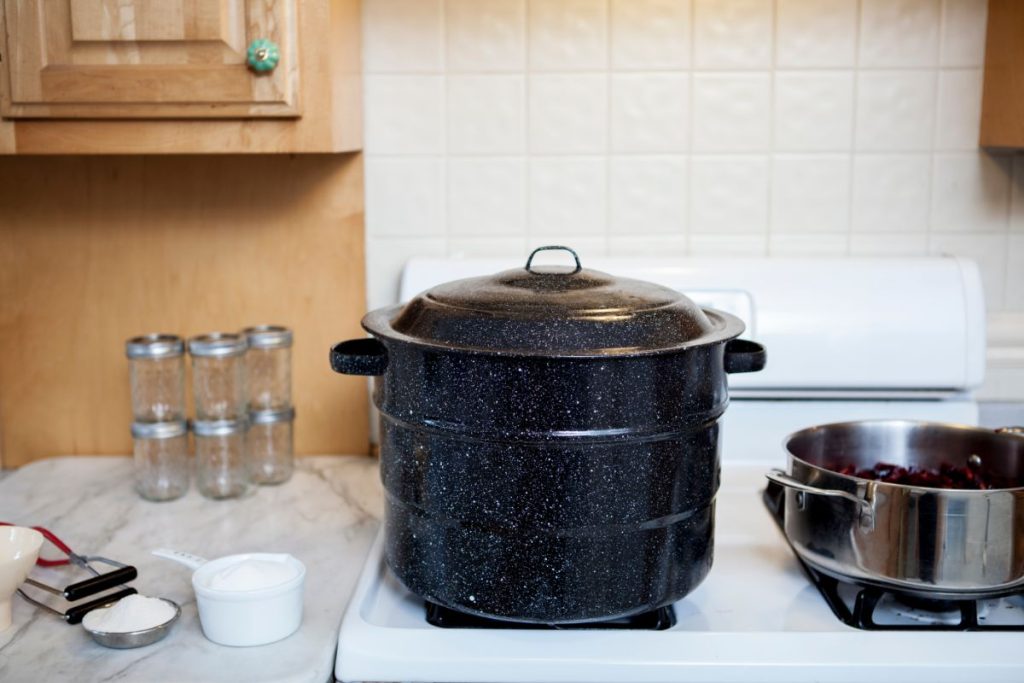
What is the Best Way to Preserve Fresh Figs?
Freezing is the best way to preserve fresh figs from your harvest for up to 6 months.
- Wash fresh, firm figs in plain water, rinse, and drain. You may peel or leave the skins intact as desired.
- For a syrup pack, combine 4 cups lukewarm water with 2 ¾ cups sugar to make heavy syrup. To improve quality, stir in ¾ teaspoon of ascorbic acid or ½ cup of bottled lemon juice per quart of syrup.
- Pack figs into freezer-safe containers and top with cold syrup leaving 1-inch headspace.
- Remove trapped air with a plastic knife, seal the containers, and put them in your freezer.
- If doing a dry pack, make an ascorbic acid solution (3/4 teaspoon ascorbic acid dissolved in 3 tablespoons cold water) and sprinkle it on the figs to prevent discoloration.
- Pack the fruits in freezer containers, leaving ½ an inch for expansion. Cover the containers with lids and freeze at 0°F.
How to Store Canned Figs
Store the jars at 50-70°F out of direct sunlight for the best-quality canned figs. Stack jars no more than two layers high, as over-stacking may tamper with vacuum seals.
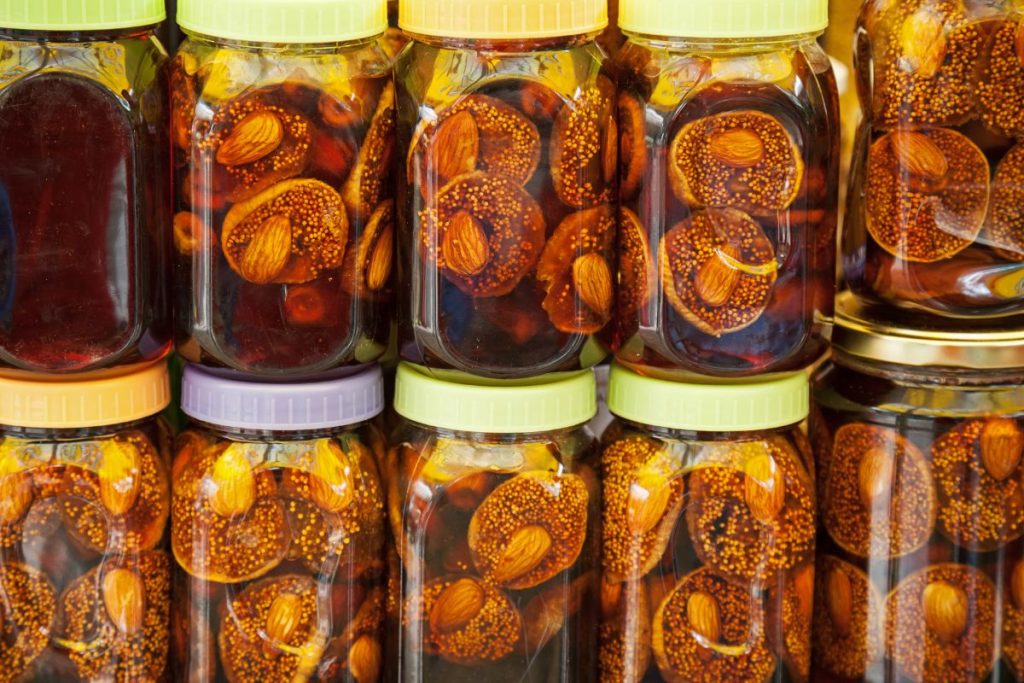
How Long Do Canned Figs Last?
If stored properly, canned figs have a shelf life of 1-2 years. The USDA recommends a best-used-by date of 12 months for best quality. Opened jars of canned goods should be refrigerated and used within 3-4 days.

